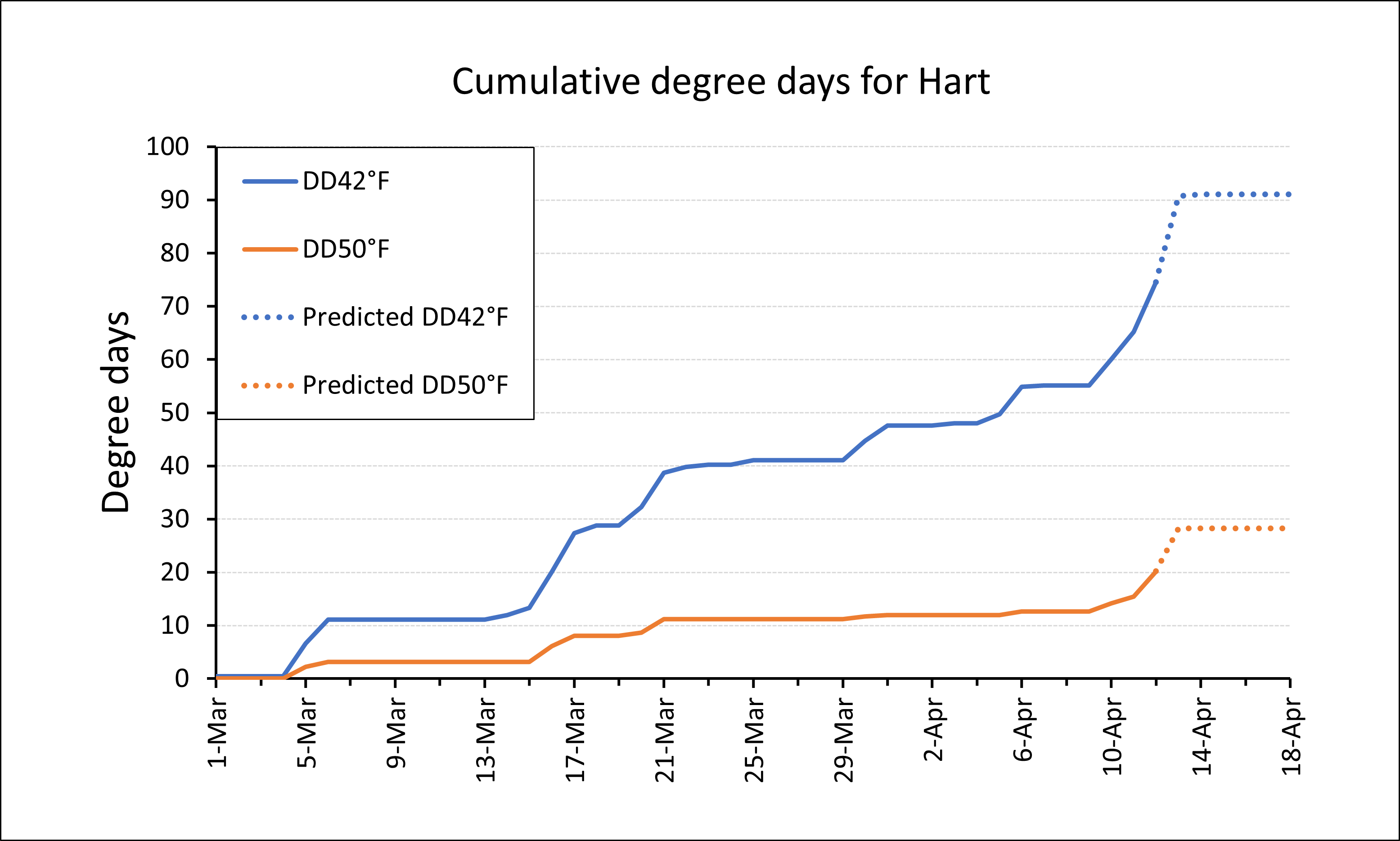West central Michigan tree fruit update – April 13, 2022
A warm up this week has led to an accumulation in degree days, but cooler temperatures into the weekend and early next week will slow development. Most buds remain dormant or show side green.

Weather update
In west central Michigan, growing degree day (GDD) accumulation is below the five-year average throughout the region (Table 1). The weekend brought cool temperatures and snow on April 9, which has kept tree fruit dormant generally. Based on the Hart Enviroweather station, warmer days early this week with high temperatures in the mid- to upper 60s have resulted in accumulation of about 23 GDD base 42 F since April 5. Current GDD accumulation is 74.7.
The Enviroweather GDD model predicts an additional accumulation of 20 GDD base 42 F on April 13 for a total of 98.8 GDD base 42 F. At base 50 F, the west central region has accumulated 24 GDD as of April 12, and an additional 10 GDD are predicted to be accumulated on April 13 (Figure 1). At Enviroweather stations across west central, GDD accumulation at base 42 F and base 50 F are lower than normal for April 12. Cool and wet weather is predicted over the next few days and into next week, which will slow GDD accumulation and tree phenology.
In the coming days, we will have cooler temperatures and scattered rain and snow showers. Over the weekend, we should see drier conditions. Temperatures are projected to remain cool early next week with highs in the 40s and low 50s. According to Michigan State University climatologist Jeff Andresen, there is a big upper air trough over the Pacific Northwest, which has created blizzard conditions and snowfall in the region. According to the National Weather Service, as this weather pattern moves east, snow fall could occur across the upper great plains and over the Midwest.

|
Table 1. Current and forecasted degree days for base 42 F and base 50 F for Enviroweather stations in west central Michigan. |
||||
|
Station |
GDD base 42 F |
Average GDD base 42 F |
GDD base 50 F |
Average GDD base 50 F |
|
Benona / Shelby |
55 |
87.1 |
14 |
24.3 |
|
Elbridge / Hart |
64 |
112.1 |
18 |
36.1 |
|
Fremont |
74 |
129.1 |
23 |
42.6 |
|
Grant* |
85 |
130.1 |
28 |
45.5 |
|
Hart |
65 |
112 |
18 |
36.3 |
|
Ludington |
59 |
107 |
15 |
34 |
|
Mears** |
68 |
159.2 |
19 |
60.7 |
|
New Era** |
66 |
150.9 |
19 |
52.8 |
*Averages were calculated using data from 2020-2021.
**Averages were calculated using data from 2018-2021.
More information and reports on normal weather conditions and departures from normal can be found on the NOAA Climate Prediction Center website, NOAA U.S. Climate Normals website, NOAA Climate Normals Quick Access Page (which may be searched by region) and Midwest Regional Climate Center website.
At warmer sites, some bud development is occurring, but the movement is slow. Growers will have a few more days to finish pruning and prepare for bud break.
Crop update
Apple varieties in Oceana County range from dormant to side green. Early varieties such as Zestar and Idared are also showing silver tip and side green, but most buds remain dormant in the region such as for Gala and Honeycrisp. As a reminder, average GDD 42 F for first green in apple is 127 for McIntosh based on over 30 years of observation from Sparta, Michigan. While other apple varieties will be ahead or behind McIntosh, our current accumulation is 57.8 GDD at base 42 F, so a continued delay in bud break and green is expected.
Tart and sweet cherry buds range from dormant to side green. If you have not been able to get out in the field yet, there is still time to apply dormant or delayed dormant applications oil or copper sprays to manage bacterial canker and early pests such as mites or scale insects.
Peaches are showing signs of swelling and side green. Be thinking about when to apply final spring dormant sprays using copper products for management of peach leaf curl and bacterial canker.
Pear varieties are dormant or at bud swell. Dormant applications of oil can still be applied to help suppress psylla and San Jose scale populations.
With continued cool and wet conditions, we will likely still have time to apply dormant sprays before bud break. It is still too cold for insect pest or disease activity in west central area orchards.
As a reminder, average GDD 42 F for first green in apple is 127 for McIntosh based on over 30 years of observation from Sparta. While other apple varieties will be ahead or behind McIntosh, our current accumulation is 57.8 GDD at base 42 F, so a continued delay in bud break and green is expected.
Pest and disease update
With continued cool and wet conditions, we will likely still have time to apply dormant sprays before bud break. It is still too cold for insect pest or disease activity in west central area orchards.
The Trevor Nichols Research Center trapped a few adult green fruitworm this week, but green fruitworm is not a major pest. If you still haven’t applied your dormant sprays such as oil or copper, be sure to do so shortly. No disease concerns have been reported for our region.
Pests to start thinking about:
- Black stem borer
- Green fruitworm
- Pear psylla
- Redbanded leafroller
- Spotted tentiform leafminor
- Obliquebanded leafroller
- Climbing cutworms
- San Jose scale
- European red mite
For more information about regional reports, please visit the Michigan State University Extension website.



 Print
Print Email
Email

